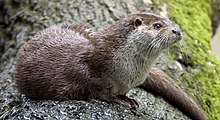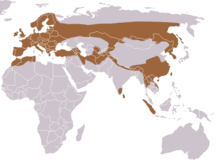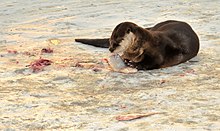Eurasian otter
| Eurasian otter | |
|---|---|

| |
| Scientific classification | |
| Domain: | Eukaryota |
| Kingdom: | Animalia |
| Phylum: | Chordata |
| Class: | Mammalia |
| Order: | Carnivora |
| Family: | Mustelidae |
| Subfamily: | Lutrinae |
| Genus: | Lutra |
| Species: | L. lutra
|
| Binomial name | |
| Lutra lutra | |

| |
| Range map | |
| Synonyms | |
|
Mustela lutraLinnaeus, 1758 | |
TheEurasian otter(Lutra lutra), also known as theEuropean otter,Eurasian river otter,European river otter,common otter,andOld World otter,is asemiaquaticmammalnative toEurasiaand theMaghreb.The most widely distributed member of theottersubfamily (Lutrinae) of theweasel family(Mustelidae), it is found in the waterways and coasts of Europe, many parts of Asia, and parts of northern Africa. The Eurasian otter has a diet mainly of fish, and is strongly territorial. It is endangered in some parts of its range, but is recovering in others.
Description
[edit]The Eurasian otter is a typical species of the otter subfamily. Brown above and cream below, these long, slender creatures are well-equipped for their aquatic habits. Their bones showosteosclerosis,increasing their density to reduce buoyancy.[2]This otter differs from theNorth American river otterby its shorter neck, broader visage, the greater space between the ears and its longer tail.[3]However, the Eurasian otter is the only otter in much of its range, so it is rarely confused for any other animal. Normally, this species is 57 to 95 cm (22.5 to 37.5 in) long, not counting a tail of 35–45 cm (14–17.5 in). The female is shorter than the male.[4]The otter's average body weight is 7 to 12 kg (15 to 26 lb), although occasionally a large old male may reach up to 17 kg (37 lb).[5][6]The record-sized specimen, reported by a reliable source but not verified, weighed over 24 kg (53 lb).[7]
Distribution and habitat
[edit]
The Eurasian otter is the most widely distributed otter species, its range including parts of Asia and northern Africa, as well as being spread across Europe, south toPalestine.Though currently thought to be extinct inLiechtensteinandSwitzerland,it is now common inLatvia,along the coast ofNorway,in the western regions ofSpainandPortugaland acrossGreat BritainandIreland.InItaly,it lives in southern parts of the peninsula.[1] It inhabits unpolluted bodies of fresh water such as lakes, streams, rivers, canals and ponds, as long as the food supply is adequate. InAndalusia,it uses artificial lakes on golf courses.[8]It prefers the open areas of the streams and also lives along the coast in salt water, but requires regular access to fresh water to clean its fur.[9]
InSyria,the Eurasian otter was recorded in montane creeks inLatakiaandRaqqa Governoratesand in the lowerEuphratesvalley inDeir ez-Zor Governorate.[10] In westernNepal,its presence was documented at elevations of around 1,600 m (5,200 ft) in Barekot river inJajarkot Districtand at 1,337 m (4,386 ft) in Tubang river inEastern Rukum District.[11] InIndia,it is distributed in theHimalayanfoothills, southernWestern Ghatsand the central Indian landscape.[12]
Behaviour and ecology
[edit]Diet
[edit]
The Eurasian otter's diet mainly consists of fish.[13]Fish is its most preferred choice of food in Mediterranean and temperate freshwater habitats.[14]During the winter and in colder environments, it also feeds onamphibians,[15][16]worms,clams,crustaceans,insects,eggs,birdsand sometimes smallmammals,including youngEuropean beavers.[17][18]It will also feed on a small amount of vegetation.[19]
As with various other mustelid species, otters are capable of overpowering and killing prey significantly larger than themselves, and are known to hunt large waterbirds such as adultgreylag geeseon occasion.[20][21]
Breeding
[edit]Eurasian otters are strongly territorial, living alone for the most part. An individual's territory may vary between about 1 and 40 km (1–25 mi) long, with about 18 km (11 mi) being usual. The length of the territory depends on the density of food available and the width of the water suitable for hunting (it is shorter on coasts, where the available width is much wider, and longer on narrower rivers). The Eurasian otter uses its feces, calledspraints,to mark its territory and prioritize the use of resources to other group members.[22]The territories are only held against members of the same sex, so those of males and females may overlap.[23]Matingtakes place in water. Eurasian otters are nonseasonal breeders (males and females will breed at any time of the year) and it has been found that their mating season is most likely determined simply by the otters' reproductive maturity andphysiologicalstate. Female otters becomesexually maturebetween 18 and 24 months old and the average age of first breeding is found to be2+1⁄2years.Gestationfor the Eurasian otter is 60–64 days, thelitterweighing about 10% of the female body mass. After the gestation period, one to four pups are born, which remain dependent on the mother for about 13 months.[24]The male plays no direct role in parental care, although the territory of a female with her pups is usually entirely within that of the male.[23]Hunting mainly takes place at night, while the day is usually spent in the Eurasian otter's holt (den) – usually a burrow or hollow tree on the riverbank which can sometimes only be entered from underwater. Though long thought to hunt using sight and touch only, evidence is emerging that they may also be able to smell underwater – possibly in a similar manner to thestar-nosed mole.[25][26]
Taxonomy
[edit]The extinctJapanese otteris sometimes considered a subspecies; recent studies have found it to fall outside the subspecific clades comprisingL. lutra,so it has been reclassified as a distinct species, but significant uncertainty remains.[27]
Conservation
[edit]The Eurasian otter declined across its range in the second half of the 20th century[28]primarily due to pollution frompolychlorinated biphenylsandpesticidessuch asorganochlorine.Other threats includedhabitat lossand hunting, both legal and illegal.[29]Eurasian otter populations are now recovering in many parts of Europe. In theUnited Kingdom,the number of sites with an otter presence increased by 55% between 1994 and 2002.[30]In August, 2011, theEnvironment Agencyannounced that otters had returned to every county in England since vanishing from every county except the West Country and parts of Northern England.[31]Recovery is partly due to a ban on the most harmful pesticides that has been in place across Europe since 1979,[32]partly to improvements in water quality leading to increases in prey populations, and partly to direct legal protection under the European UnionHabitats Directive[33]and national legislation in several European countries.[34][35][36]InHong Kong,it is aprotected speciesunder Wild Animals Protection Ordinance Cap 170. It is listed asNear Threatenedby theIUCN Red List.[1]
InGermany,the Eurasian otter is nearly extinct in the wild, being listed as critically endangered. As part of a protection and conservation effort the "Aktion Fischotterschutz" was founded in 1979, which aims to fund habitat protection and expansion.[37]Further, theHankensbüttler Otter Centreprovides protection to the species in captivity.[38]
It is listed as endangered in Pakistan, India,Bangladesh,Myanmarand Thailand, and critically endangered inMongolia.[1]InSouth Korea,it is listed as a Natural Monument[39]and first-class endangered species.[40]
Most species that are victims of population decline or a loss of habitat tend to eventually lose their genetic difference due to inbreeding from small populations. A study conducted in 2001, examined whether or not the populations of Eurasian otters suffered from a lack ofgenetic variability.In the study, they examined teeth of otter skulls at theZoological Museum, Copenhagenand theNatural History Museum, Aarhus.The samples were collected between 1883 and 1963 in Denmark (Funen,Zealand,andJutland). The study examined the tissue on the teeth of the skulls and determined the genetic variability based on DNA analysis. In conclusion, the study discovered that despite the population declines, the Eurasian otter was not a victim of declining genetic variability.[41]
The decline in population of native freshwater fishes in the rivers ofIberia,which is the preferred food of Eurasian otters, along with the expansion of exotic fish species likecentrarchidscould potentially put Eurasian otters at risk for extinction.[42]
References
[edit]- ^abcdeLoy, A.; Kranz, A.; Oleynikov, A.; Roos, A.; Savage, M.; Duplaix, N. (2022)."Lutra lutra".IUCN Red List of Threatened Species.2022:e.T12419A218069689.doi:10.2305/IUCN.UK.2022-2.RLTS.T12419A218069689.en.Retrieved14 December2023.
- ^Hayashi, S.; Houssaye, A.; Nakajima, Y.; Chiba, K.; Ando, T.; Sawamura, H.; Inuzuka, N.; Kaneko, N.; Osaki, T. (2013)."Bone Inner Structure Suggests Increasing Aquatic Adaptations in Desmostylia (Mammalia, Afrotheria)".PLOS ONE.8(4): e59146.Bibcode:2013PLoSO...859146H.doi:10.1371/journal.pone.0059146.PMC3615000.PMID23565143.
- ^Godman, John Davidson (1836)American Natural History,Hogan & Thompson.
- ^Hans, Kruuk (2007).Otters ecology, behavior and conservation.Oxford University Press.ISBN978-0-19-856587-1.
- ^European Otter.theanimalfiles.com
- ^European otterArchived2011-12-23 at theWayback Machine.purpleopurple.com
- ^Wood, Gerald L. (1983)The Guinness Book of Animal Facts and Feats.Sterling Pub Co Inc.,ISBN978-0-85112-235-9
- ^Duarte,? (2011)."The Use of Artificial Lakes on Golf Courses as Feeding Areas by the Otter (Lutra lutra) in Southern Spain ".IUCN Otter Specialist Group Bulletin.28.
- ^Ozkazanc, N.K.; Ozay, E.; Ozel, H.B.; Cetin, M.; Sevik, H. (2019). "The habitat, ecological life conditions, and usage characteristics of the otter (Lutra lutraL. 1758) in the Balikdami Wildlife Development Area ".Environmental Monitoring and Assessment.191(11): 645.Bibcode:2019EMnAs.191..645O.doi:10.1007/s10661-019-7833-1.PMID31617007.S2CID204707562.
- ^Aidek, A.; Baddour, F.S.; Ibrahim, N.N. & Al-Sheikhly, O.F. (2021)."The first photographic records of the Eurasian OtterLutra lutrain Syria: Its mysterious occurrence is revealed ".IUCN Otter Specialist Group Bulletin.38(5): 258–266.
- ^Shrestha, M.B.; Shrestha, G.; Reule, S.; Oli, S.; Ghartimagar, T.B.; Singh, G.; Tripathi, D.M.; Law, C.J.; Shah, K.B. & Savage, M. (2021)."First evidence of Eurasian Otter in Nepal in three decades".IUCN Otter Specialist Group Bulletin.38(5): 279–291.
- ^Joshi, A.S.; Tumsare, V.M.; Nagar, A.K.; Mishra, A.K. & Pariwakam, M.P. (2016)."Photographic records of Eurasian OtterLutra lutrafrom the Central Indian landscape ".IUCN Otter Specialist Group Bulletin.33(1): 73–78.
- ^Jędrzejewska, B.; Sidorovich, V. E.; Pikulik, M. M.; Jędrzejewski, W. (2001). "Feeding habits of the otter and the American mink in Białowieża Primeval Forest (Poland) compared to other Eurasian populations".Ecography.24(2): 165–180.Bibcode:2001Ecogr..24..165J.doi:10.1034/j.1600-0587.2001.240207.x.
- ^Clavero, M.; Prenda, J.; Delibes, M. (2003-05-01). "Trophic diversity of the otter (Lutra lutraL.) in temperate and Mediterranean freshwater habitats ".Journal of Biogeography.30(5): 761–769.Bibcode:2003JBiog..30..761C.doi:10.1046/j.1365-2699.2003.00865.x.hdl:10272/2962.S2CID86541901.
- ^Pagacz, Stanisław; Witczuk, Julia (2010)."Intensive exploitation of amphibians by Eurasian otter (Lutra lutra) in the Wolosaty stream, southeastern Poland "(PDF).Annales Zoologici Fennici.47(6): 403–410.doi:10.5735/086.047.0604.S2CID83809167.
- ^Weber, J.-M. (1990). "Seasonal exploitation of amphibians by otters (Lutra lutra) in north-east Scotland ".Journal of Zoology.220(4): 641–651.doi:10.1111/j.1469-7998.1990.tb04740.x.
- ^Kitchener, A. (2001).Beavers.Whittet Books. p. 144.ISBN978-1-873580-55-4.
- ^"Lutra lutra (European otter)".Animal Diversity Web.
- ^"Lutra lutra (European otter)".Animal Diversity Web.
- ^Yardley, Adam (2016-06-07)."Goslings & Otters".Norfolk Broads Direct.Retrieved2022-07-24.
- ^"Ullswater geese deaths: Park rangers probe mystery of vanishing birds".BBC News.2022-06-30.Retrieved2022-07-24.
- ^Kruuk, H. (1992). "Scent marking by otters (Lutra lutra): signaling the use of resources ".Behavioral Ecology.3(2): 133–140.doi:10.1093/beheco/3.2.133.
- ^abErlinge, S. (1968). "Territoriality of the otterLutra lutraL. ".Oikos.19(1): 81–98.Bibcode:1968Oikos..19...81E.doi:10.2307/3564733.JSTOR3564733.
- ^Hauer, S.; Ansorge, H.; Zinke, O. (2002)."Reproductive performance of ottersLutra lutra(Linnaeus, 1758) in Eastern Germany: Low reproduction in a long-term strategy ".Biological Journal of the Linnean Society.77(3): 329.doi:10.1046/j.1095-8312.2002.00097.x.
- ^Alleyne, R. (2010)."Can otters smell underwater?".Daily Telegraph.London. Archived fromthe originalon 2010-06-08.Retrieved2010-06-06.
Hamilton James said: "I always had an inkling that otters could smell under water and I wanted to prove it. As it was dark and the fish was fully submerged, it proved that the otters had to be using a sense other than sight or touch to locate it. After reviewing the footage I noticed a tiny bubble which hit the fish and was sniffed back in by the otter."
- ^Director: Richard Taylor Jones; Camera Operators: Richard Taylor Jones,Charlie Hamilton James;Producer:Philippa Forrester(2010-06-06)."Late Summer".Halcyon River Diaries.Episode 4. London.BBC.BBC One.
- ^Park, H.-C.; Kurihara, N.; K., K. S.; Min, M.-S.; Han, S.; Lee, H.; Kimura, J. (2019)."What is the taxonomic status of East Asian otter species based on molecular evidence?: focus on the position of the Japanese otter holotype specimen from museum".Animal Cells and Systems.23(3): 228–234.doi:10.1080/19768354.2019.1601133.PMC6567078.PMID31231587.
- ^"The Eurasian Otter (Lutra lutra) ".English Nature.Retrieved2010-03-15.
- ^"Otter: Background to selection".Jncc.gov.uk.Retrieved2010-03-15.
- ^"Fourth Otter Survey of England".NHBS.Retrieved9 October2020.
- ^Michael McCarthy (2011-08-18)."Otters return to every county in England".The Independent.Retrieved2011-08-19.
- ^"Council Directive 79/117/EEC of 21 December 1978 prohibiting the placing on the market and use of plant protection products containing certain active substances".EUR-Lex.Retrieved2010-03-15.
- ^"Council Directive 92/43/EEC of 21 May 1992 on the conservation of natural habitats and of wild fauna and flora".EUR-Lex.Retrieved2010-03-15.
- ^"Species other than birds specially protected under The Wildlife and Countryside Act, 1981: Schedule 5 (Animals)".JNCC. 2005-08-30. Archived fromthe originalon 2009-01-22.Retrieved2010-03-15.
- ^"Wildlife Act 1976 (Ireland)".International Wildlife Law. 1976-12-22. Archived fromthe originalon December 8, 2006.Retrieved2010-03-15.
- ^"Otters of the world - Europe".IOSF.
- ^"Start - Aktion Fischotterschutz e.V."aktion-fischotterschutz.de.Retrieved2024-07-27.
- ^"Tier- und Freizeitpark | OTTER-ZENTRUM Hankensbüttel".otterzentrum.de.Retrieved2024-07-27.
- ^"천연기념물 제330호 수달"(in Korean). heritage.go.kr.Retrieved18 January2021.
- ^"국립생물자원관 한반도의 생물다양성-수달"(in Korean). species.nibr.go.kr.Retrieved18 January2021.
- ^Pertoldi, Cino; Hansen, Michael Møller; Loeschcke, Volker; Madsen, Aksel Bo; Jacobsen, Lene; Baagoe, Hans (2001-09-07)."Genetic consequences of population decline in the European otter (Lutra lutra): an assessment of microsatellite DNA variation in Danish otters from 1883 to 1993".Proceedings of the Royal Society of London B: Biological Sciences.268(1478): 1775–1781.doi:10.1098/rspb.2001.1762.ISSN0962-8452.PMC1088808.PMID11522195.
- ^Blanco-Garrido, Francisco; Prenda, José; Narvaez, Marta (2008)."Eurasian otter (Lutra lutra) diet and prey selection in Mediterranean streams invaded by centrarchid fishes ".Biological Invasions.10(5) (published 12 September 2007): 641–648.Bibcode:2008BiInv..10..641B.doi:10.1007/s10530-007-9158-1.S2CID22692586– viaSpringer Link.
Further reading
[edit]- Laidler, Liz.Otters in Britain.David & Charles, 1982.ISBN0715380699

